This article contains expert-led insights from a previous season of the Million Dollar Case Study. MDCS is a free, comprehensive video series by Jungle Scout in which veteran Amazon sellers show budding entrepreneurs how to succeed on Amazon—by actually doing it. The series takes viewers step by step through the process of launching a real product on Amazon in real time—from product research to finding a supplier to advertising. Check out our most current season here for the latest information on selling on Amazon.
Welcome to Session #1 of the second part of our Million Dollar Case Study. Just in case you are new here, we are on a journey to build and scale an Amazon business and generate $1 Million dollars in revenue. The profits of which are being donated to Pencils of Promise and every single step of the way is being documented each week for you to follow along in real time.
In this second part of the case study, we are starting the process again. We are going to scale our business by launching in Europe!
Who am I?
I’m Kym, and I am part of the marketing team here at Jungle Scout. I will be joining Greg each week and he is going to mentor me in this process. I’m actually from Europe myself (UK), and whilst I have been involved in helping out with Jungle Snugs and Jungle Stix, our existing private label products, I have never launched my own product on Amazon before.

But, with Greg’s mentorship, I am going to do just that.
I was very excited when Greg asked me to join him on the Million Dollar Case Study to expand our growing Amazon business. This case study is something we are all very proud of as a company, especially with the philanthropical mission of raising money to build schools in developing countries. Also, we have never covered the topic of selling in Europe before, so I’m stoked to be a part of bringing new insightful content to you!
It’s going to be a great experience and we hope to address some of the common problems or questions that you might have, as I will experience many of them too.
Watch the first session here:
Before I get into the recap for this first session, here is the full replay:
And the slides:
Amazon Private Label: The Opportunity
First off, Greg wanted to share some insights about the opportunity of becoming a private label Amazon seller, for those of you who know less about it.
To put it into a short sentence: private labeling on Amazon consists of finding an existing product with demand, sourcing it from China, importing it and then selling it using Amazon’s fulfillment services. The benefits are that it’s relatively easy to get started with a low barrier to entry. Plus, it can be very profitable and easy to grow your business, and you can do this from anywhere in the world!

This type of business endeavor is great for people who want a side income, as well as the more aspirational entrepreneur who wants to replace their current income. Imagine being able to get an extra income of 4-5k per month? This is actually very achievable. In fact, in our survey of over 2500 Amazon sellers, we found that by 18 months after starting an Amazon business, at least 50% of sellers were bringing in $10k per month!
Greg himself replaced his full-time income as a civil engineer before he created Jungle Scout, and is still selling on Amazon to this day. From personal experience, I have always had a “side hustle” in photography, but that is more of a passion. It requires a lot of time, equipment, and relies on me being somewhere physically to make money from photography. If I were to launch on Amazon, I could replace this from anywhere in the world.
When Greg asked his wide circle of peers, the things that they said they would do by becoming a successful seller included:
- Travel more
- Pay off debt
- Quit their job
- Invest in retirement
- Financial freedom…
What We Have Achieved So Far!
To recap our journey to $1 million so far, we have:
- In 2016 we launched Jungle Stix and sold $287k in the past 18 months
- In June 2017, we launched Jungle Snugs which is growing quickly, has sold $19k and became profitable
- Total sales to date: $306k – 30% of our goal to a million
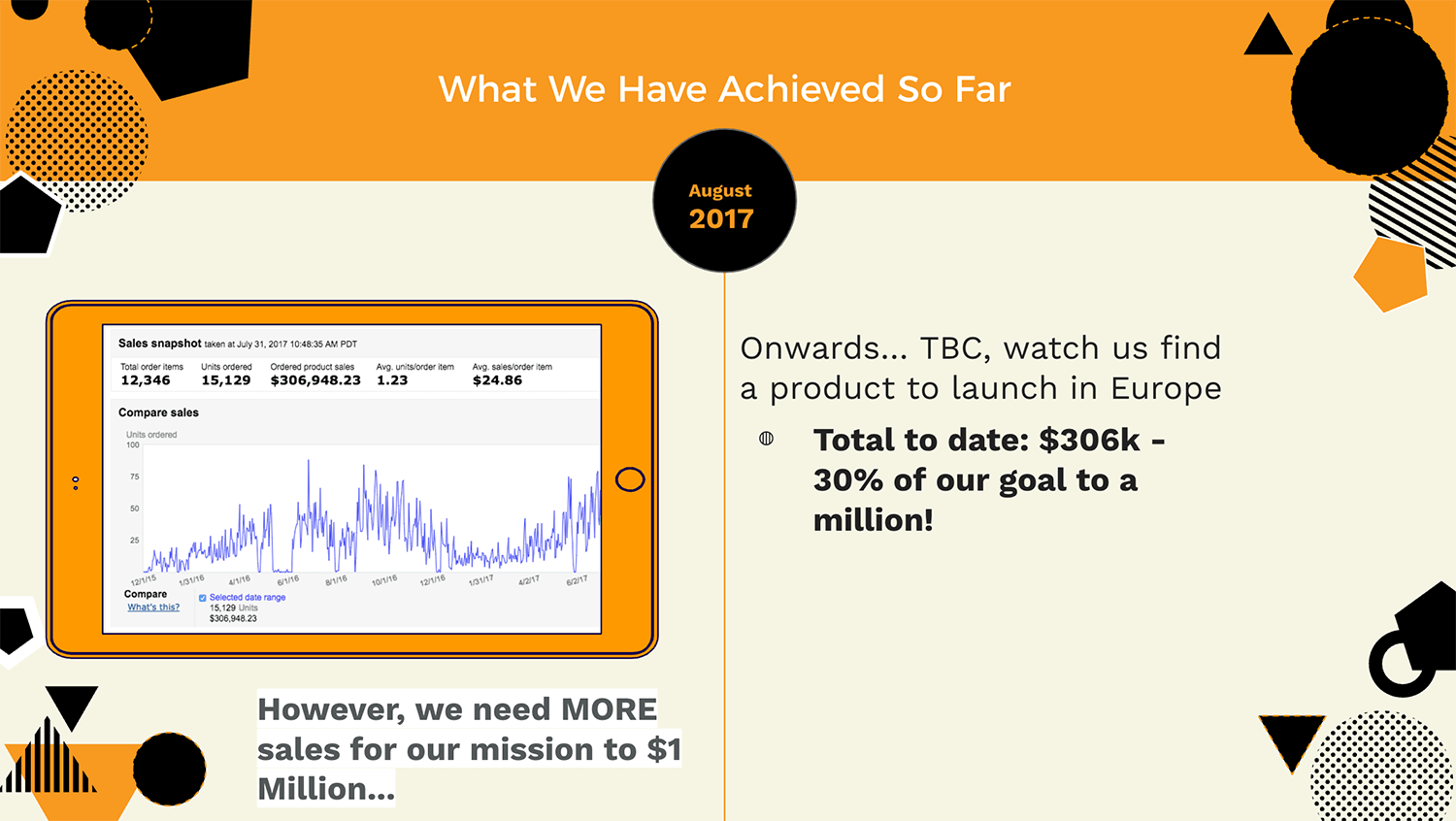
But this isn’t enough. If we want to hit our target we need to keep growing our business, otherwise, it will take three years and as they say on the internet, ain’t nobody got time for that!
Onwards… to Europe!
So why Europe, you may ask. Well, we have reasons and data to answer that question.
Firstly, the European marketplaces are growing quickly, but they are still much less saturated and there is much less competition when compared to Amazon.com. In particular, Amazon.co.uk and Amazon.de are the largest marketplaces within Europe, that hold a lot of opportunity:
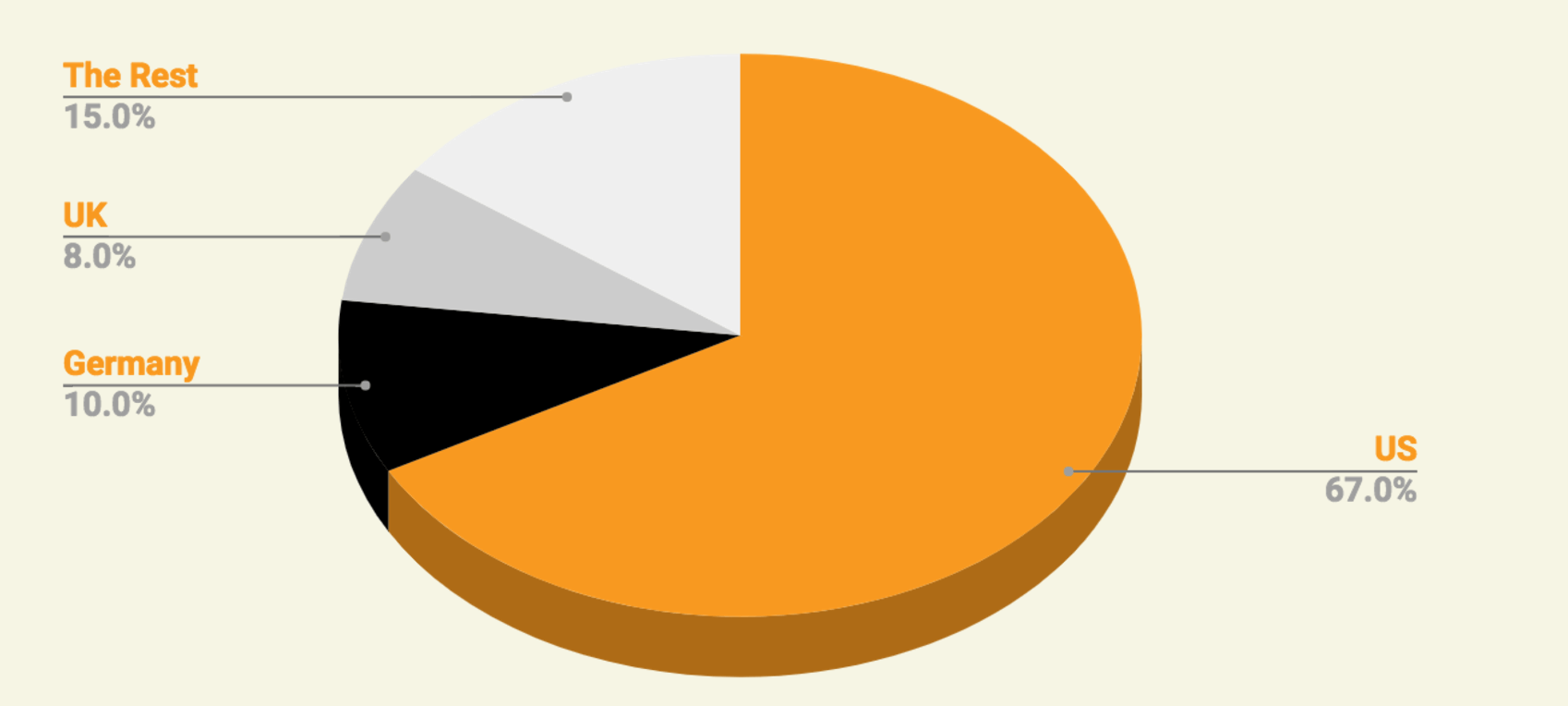
Again taking insights from our seller survey, the sellers that sold in two markets instead of one increased their profits by an average of 40%:
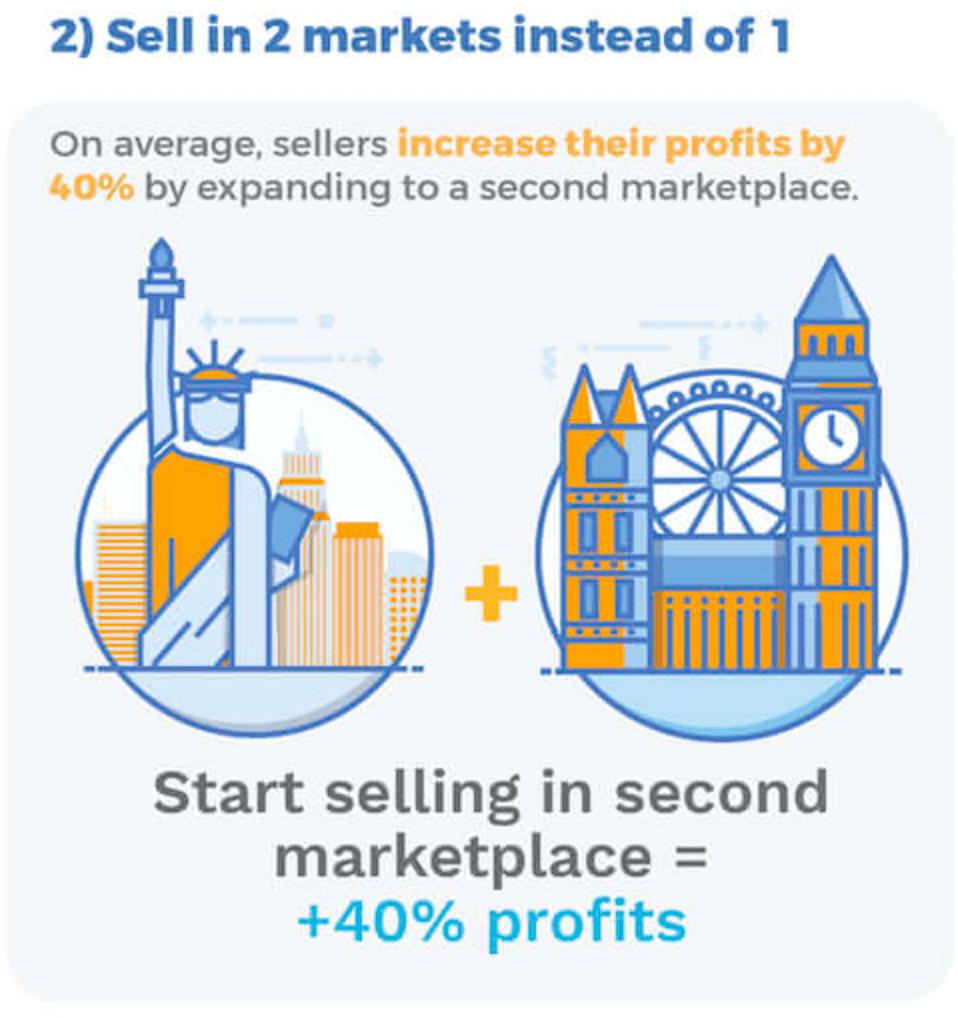
Not only that, as Greg mentions in the webinar, the goal of our case study is to provide the best learning platform for other people to make the most of this opportunity. We want to make this case study applicable for everyone. That includes Amazon sellers in the US, across Europe and the rest of the world.
If you are following along right now but want to start your business in the US, then you can still apply these same learnings. If you are looking to grow your business internationally, then we’re going to cover a lot of the admin and logistical aspects of selling abroad, too!
Finding Product Ideas On Amazon EU
So let’s dive in with some product research and mine for some neat product ideas, shall we? Here’s what we looked at in this session:
- A revised blueprint for finding product opportunities in different markets
- Searching for product ideas in European marketplaces
- Building a list of product ideas
- HOMEWORK: Tasks to complete before next week’s session 🎓
The Revised Product Blueprint For European Markets
So first up, the blueprint. We have covered this several times before but the bare essentials stay the same no matter which country you are selling in. Here’s what you are looking for:
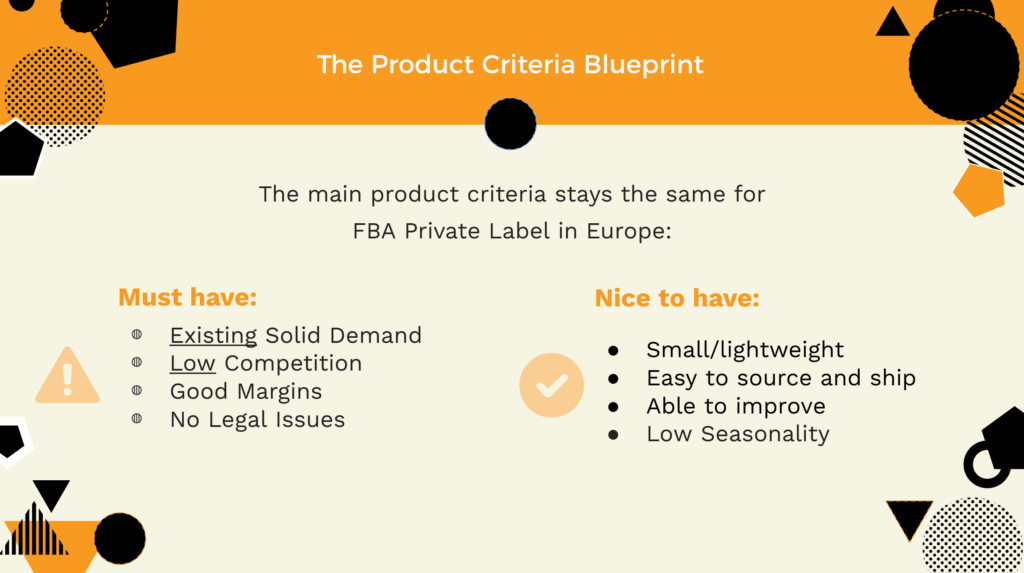
What does change are the amount of monthly sales and reviews that you are looking for in existing products that are already being sold on Amazon. Since the size and depth of the European markets are different to the US, you need to bear this in mind. Here’s a comparison including the UK and Germany:
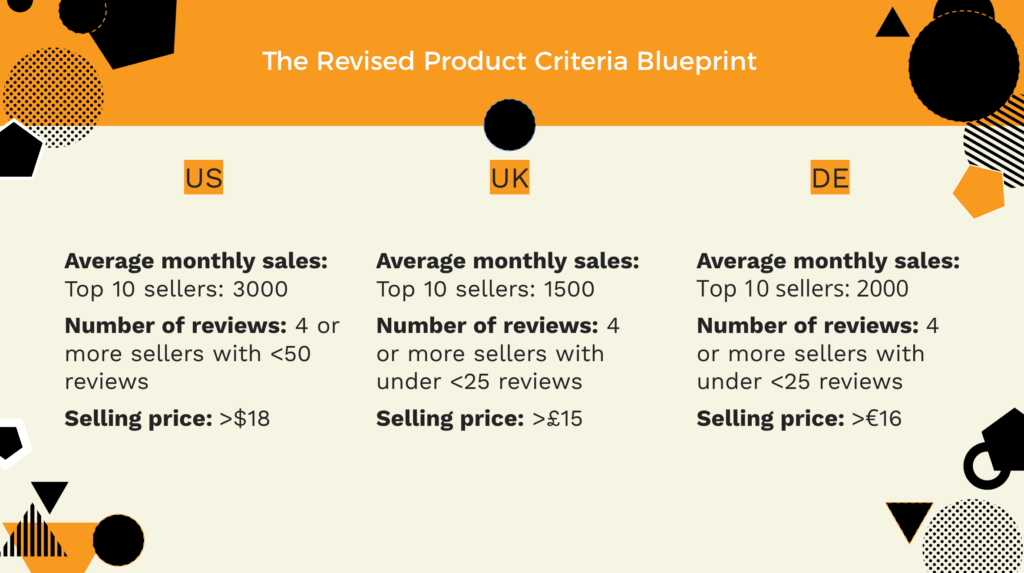
Let’s Find Some Product Ideas
Once Greg had explained the criteria we were looking for, it was time for me to share my screen and start searching for some product ideas that fit the bill. I had Greg there to answer any questions I had along the way.
I am using a spreadsheet to document all of my ideas in one place. You can access the template here, and download your own copy. (PS, you will need this for your homework). 😉
Here’s what that looks like:
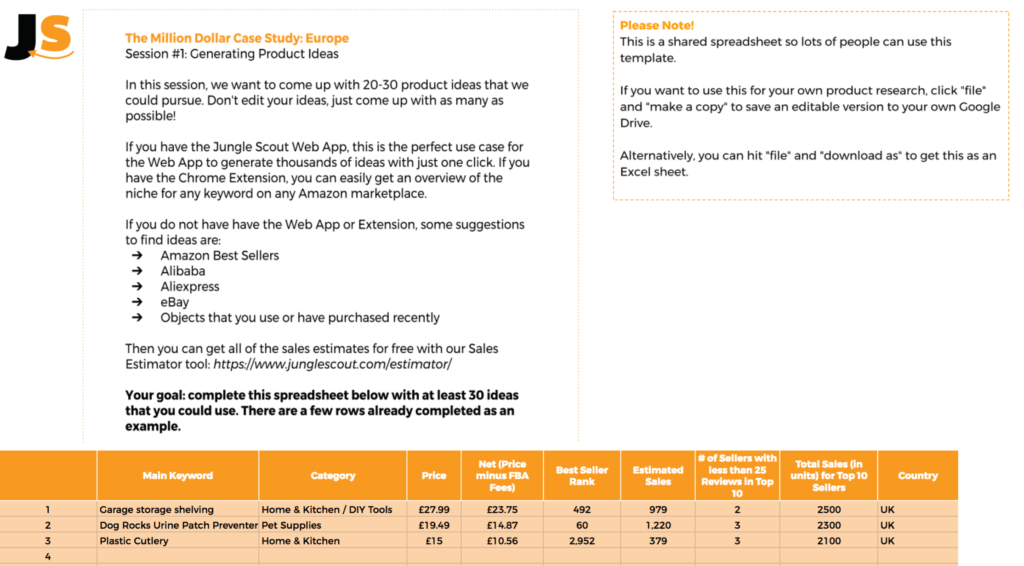
You can see that there is a bunch of information I am looking for that Greg has just explained as being important to identify an opportunity. Right now, I want to try and generate a big list of ideas (30 or more), that I can dive into next week. So to do this, I am going to use Jungle Scout and then Extension.
You don’t have to use our tools to do this, however, I will be since it makes it so much quicker!
If you don’t have any of the JS tools, you can use our free estimator, to get rough estimates for any product ideas you discover.
Using Jungle Scout To Find Unique Products
I am going to be looking for an opportunity in the UK, because it’s slightly easier as I speak English. Having said that, it’s not impossible to look for product opportunities in Germany even if you don’t speak German, as we’re looking at cold hard data here.
My first port of call was to use a specific set of filters to search the Product Database in Jungle Scout, to get a list of products that meet my criteria. Here are the filters I used:

You can see that I have used Greg’s advice and selected:
- A minimum price of £15 – so that the products we find have more chance of giving us some profit margins
- Minimum estimated monthly sales of 200 – because we want to find products that have demand and where the top 10 sellers are shifting more than 1500 units per month
- A maximum number of reviews at 25, because we also want to find products with low enough competition for us to go up against
When I hit return, I get a host of products, alongside all of the relevant data, an image and a link directly to the Amazon listing page:
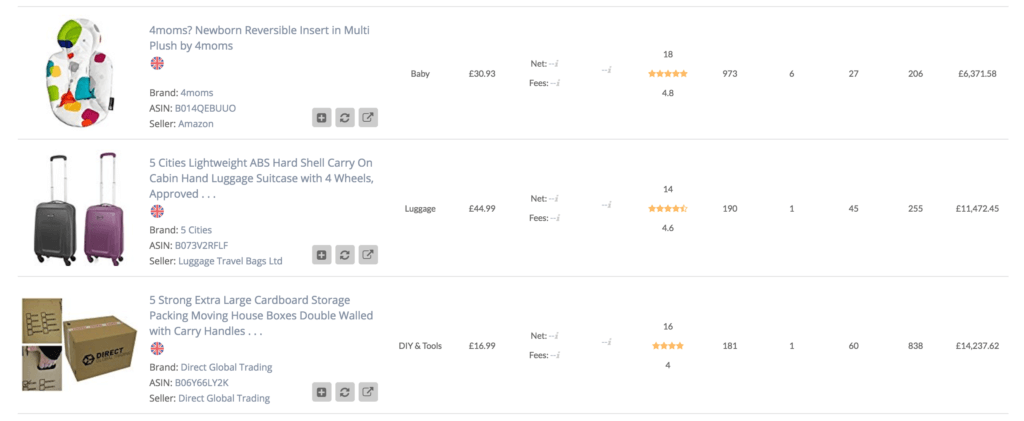
Browsing Tools Or Amazon For Product Ideas: What To Look For!
At this point, I am mostly relying on looking at pictures to skim through lots of products and identify good ones to investigate. Here are the key things that I had in the back of my mind:
- Is it easy and inexpensive to manufacture and import?
- Avoid any legal issues or big brands – we’re not going to be selling any PS4 games or Nike shoes, for example!
- Is it easy and inexpensive to ship? Think about things like, is it fragile, or heavy?
- Does it pass Greg’s “weirdness test” – Greg always mentions that unique items can be real winners for private label, so if I find something strange I want to investigate further.
When I found something that seemed like it is a solid idea, I would then take a look at the estimated monthly sales and if that looks promising, I will open up those products on Amazon.co.uk in a new tab.
During this webinar I managed to pick out 5 products using the above criteria, which were:
Exploring A Niche On Amazon With Extension
With my five product ideas open in new tabs, I then checked them out in more detail using Extension. To do this I simply searched on Amazon.co.uk for a main keyword for each product under “all departments” and then opened up the extension on the results page for that keyword:

Now that I can see the top 10 ranked products for this keyword, it starts to put things into perspective. In this example, I can see that estimated sales across these sellers, as well as gauge the competition levels by seeing how many reviews the sellers have got.
This particular product has very high demand, but it’s also quite competitive. But equally, it would be extremely cheap to manufacture and import, so this product goes on my spreadsheet. I will fill out as much data as possible for each product idea so that I don’t forget any of it.
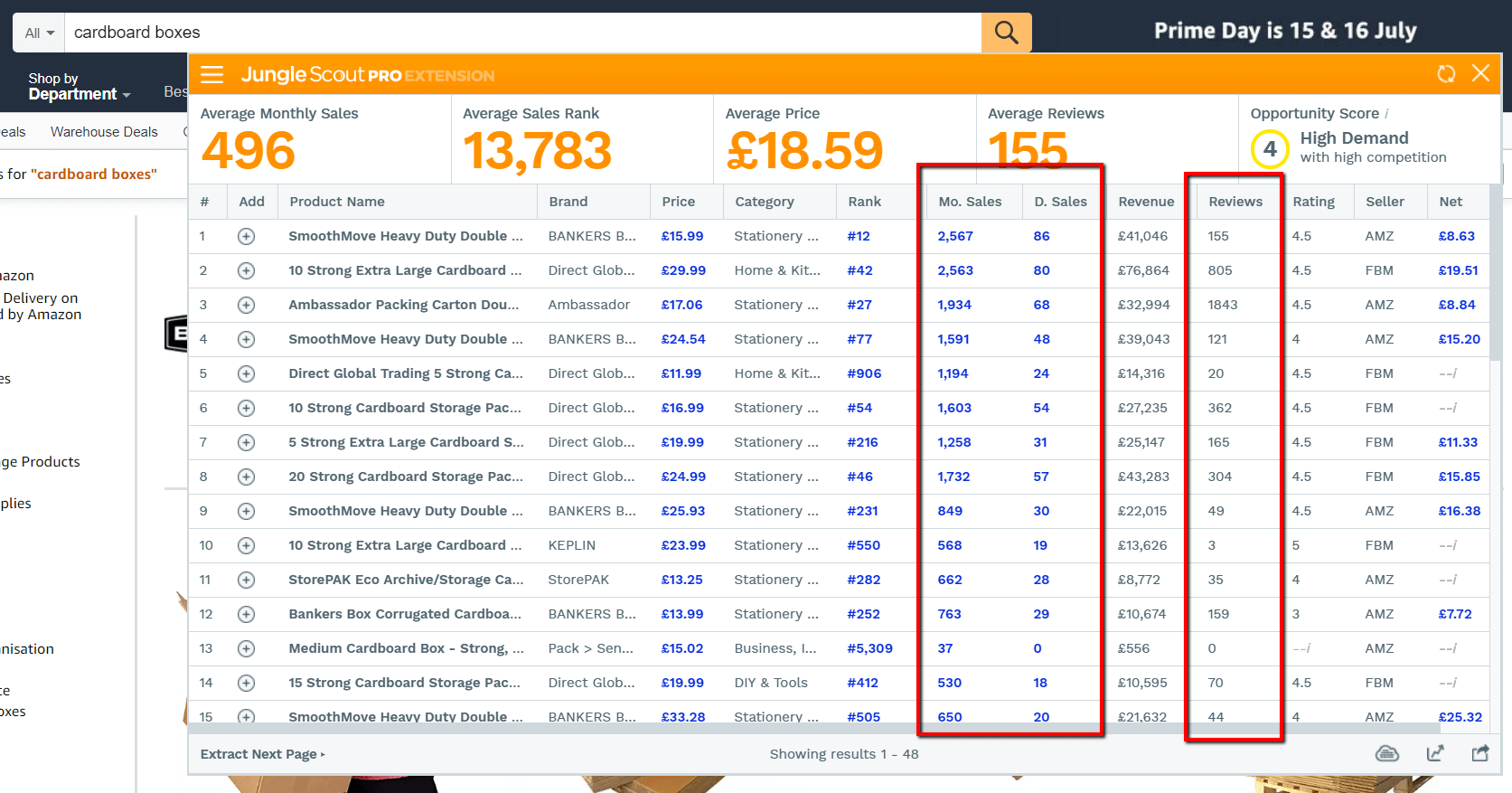
Out of the five products I opened in a new tab, four of them seemed like decent opportunities. Only one didn’t make it to my list, which was the reading glasses. This is because although there was high demand, most sellers were selling them at much less than £15, so profits would be low.
To get a full view of how I analyzed each product over my shoulder, make sure you watch the replay at the top of this post!
Things To Look Out For
Whilst I was going through these 5 product ideas, I had a few questions for Greg and we highlighted some interesting things to look out for.
- Depth of market – If there is one seller dominating a product idea, and quite a few other sellers shifting a low amount of units per month, then we need to be cautious. Requires further investigation! If one seller is doing really well but all of the others are struggling, there is often a reason for that. Requires further investigation!
- Going against Amazon – For a few of these ideas, I noticed Amazon was selling an item in the top 10 sellers. Greg’s take on this is that we don’t mind competing with Amazon as their listings usually suck(!) and Amazon actually wants third-party sellers to succeed because it means they can get more fees. So don’t let this put you off completely.
- Using a more specific keyword – When we researched “plastic cutlery” the results were varied and the average price was below £15. Not ideal. However, when we searched for something more specific like “metallic plastic cutlery”, the results were more promising. We actually saw the same thing when we launched Jungle Snugs and searched for “baby towels” versus “hooded baby towels”. Sometimes, it’s worth trying a more specific keyword!
Over To You: Homework
Alright, that’s the recap covered. Over the next week, I am myself going to continue this research and create a killer list of product ideas. I would like to invite you to do the same, so that next week when we take a look deeper into these products with some advanced research tactics, you’ll be ready to go!
Don’t forget you can use the same spreadsheet template I used: DOWNLOAD IT HERE!
Our mantra at Jungle Scout is to get started. The longer you wait to start this process, the more time you are wasting not being able to generate extra income. So I hope you will take this opportunity to start your research and join us on this journey.
Next Steps
In the next session, we took a deeper look at my full list of product ideas and add some more columns to the product research spreadsheet. Follow along to find out how to narrow down your list of ideas to verify the one that could be your next venture in business!
Remember, you can get the full progress of MDCS: Europe with full recaps here.
If you are enjoying our case studies, we’d love it if you could subscribe to our YouTube channel – it’s our hub for new informational content about how to sell on Amazon.

 57 Comments
57 Comments
57 comments on “The Million Dollar Case Study: Europe – Session #1: Finding Product Ideas”